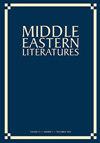Is the Arab nahḍah really Arabic? Literary translingualisms in the nahḍah's contact zones
IF 0.2
4区 文学
0 LITERATURE
引用次数: 1
Abstract
ABSTRACT Against the perception of the nahḍah’s literati in Egypt and the Arab mashriq as being narrowly monolingual, due to their literary use of fuṣḥā Arabic and the various ʿāmmiyyahs, this article highlights literary translingual practices in the nahḍah’s contact zones in Egypt, Syro-Lebanon, and Iraq. Literary translingualisms took various forms such as bi-or-translingual azjāl (“vernacular verse”) and mulammaʿāt (macaronic verse), as well as self-translations. This article focuses on literary translingual practice manifest in the zajal of Muḥammad ʿUthmān Jalāl, Badīʿ Khayrī, Bayram al-Tūnisī, and ʿAlī Diyāb, as well as the mulammaʿāt of ʿAbbūd al-Karkhī. The intricate relations of power among the languages of the nahḍah (i.e. Persian, Ottoman Turkish, and fuṣḥā Arabic in addition to a host of European languages, especially French and English) are also featured in the literary works of authors such as ʿĀʾishah Ismāʿīl Taymūr and Hijri Dede.阿拉伯人nahḍah真的是阿拉伯人吗?nahḍah接触区域的文学翻译
由于在文学上使用fuṣḥā阿拉伯语和各种各样的āmmiyyahs语,人们认为埃及的nahḍah文人和阿拉伯的mashriq只会说一种语言,而本文则强调了在埃及、叙利亚-黎巴嫩和伊拉克的nahḍah接触区内的文学翻译实践。文学翻译有多种形式,如双语或译语azjāl(“白话诗”)和mulamma ā āt(马卡文诗),以及自译。这篇文章的重点是文学翻译实践,体现在Muḥammad - Uthmān Jalāl的扎哈尔,巴德-海伊尔,拜拉姆al-Tūnisī,和al- Diyāb,以及al- Abbūd的穆拉玛- āt。nahḍah语言(即波斯语、奥斯曼土耳其语和fuṣḥā阿拉伯语以及许多欧洲语言,特别是法语和英语)之间错综复杂的权力关系也出现在诸如al - Ā和al - Taymūr和al - Dede等作家的文学作品中。
本文章由计算机程序翻译,如有差异,请以英文原文为准。
求助全文
约1分钟内获得全文
求助全文

 求助内容:
求助内容: 应助结果提醒方式:
应助结果提醒方式:


